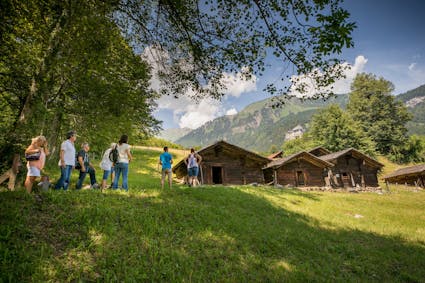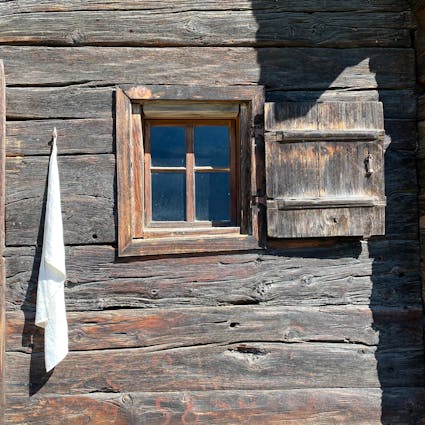1341–1345 – Alpine Buildings from Richinen/Bellwald, Valais, 17th–19th Centuries
In the 20th century there were 39 buildings and a chapel in Alpstafel – the place was practically a hamlet.

Summer Stress
The farmer’s family enjoys no vacation in summer – that’s the hardest time of the year. Mowing grass, bringing it in, mowing hay, bringing that in, tending the fields and gardens, harvesting grain, tending the cattle up on the alp at the same time, milking twice a day, processing the milk – an alpine nightmare.

Diverse Solutions
for the Alp The weeks from June till September are full of work. Tending the high alp and spending hours making cheese give the farmer headaches enough. In an alp-cooperative it was possible to employ herders, milkers and cheese[1]makers in common: a team of three to five hands could manage all of the livestock up on the mountain. The farmers could stay down in the valley and do the haying. An alternative was the individual alp, or family alp: each family remained in the village and sent someone up each day to take care of their own livestock.

Little Alpine Village
Individual alp management was the rule in Richinen above Bellalp in the Goms region of the Valais. Each family had its own alp hut. In the 20th century there were 39 buildings and a chapel in Alpstafel – the place was practically a hamlet. The timber buildings on brokenstone foundations had only a single storey and mostly only a single room. Decoration was limited to a frieze carved on a door jamb and a horsehead on a beam end.

Moving to the Museum
In 1970 a large cooperative stall with a new dairying hut was built, and the old huts went unused. The alp cooperative voted to tear them down. The Ballenberg Open-Air Museum took over five buildings: a herder’s hut for cheesemaking and two stalls as well as two more herder’s huts that were later converted into a stall and a cheese store. In this little settlement you can see the group picture these buildings once made at their original location.

For Ever and Ever?
Culture is not just a constant and not always the same. Culture is made by people and in continuous flux. Traditions are regionally different; customs change. In earlier times in the alpine region it was no different. There were various or even contradictory forms of organisation in the alpine economy. In the Valais we find cooperative alps with large buildings in one place and, in the next valley, family alps with several small buildings. The help on one alp was entirely male and on the other side of the mountain solely women tended the livestock. Systems also changed: individual alp farming was predominant in Bellwald until 1937, then cooperative alp farming took over.
Ballenberg
Swiss Open-Air Museum
Museumsstrasse 100
CH-3858 Hofstetten bei Brienz
Opening hours
11 April to 27 October 2024
10 am to 5 pm daily